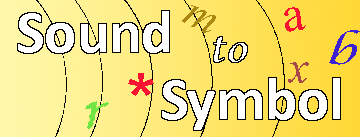



Letters As Diagrams Of Sound. Like many things in life we accept the shapes of the letters of the alphabet as something that has been passed down by tradition without giving them much thought.
If you become aware of the sensation produced in the mouth and throat when you voice the basic sounds of the letters you may notice the letter shapes have a similarity to the shapes made by the sound.
Letters are shapes drawn on a two-dimensional grid provided by the surface of a page. |
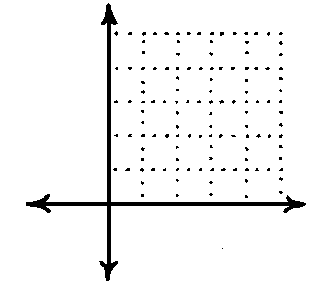 |
|
They are representations of what is happening in the three-dimensional reality of our mouths, (and bodies), as we make each sound (in the fourth-dimension of time). |
||
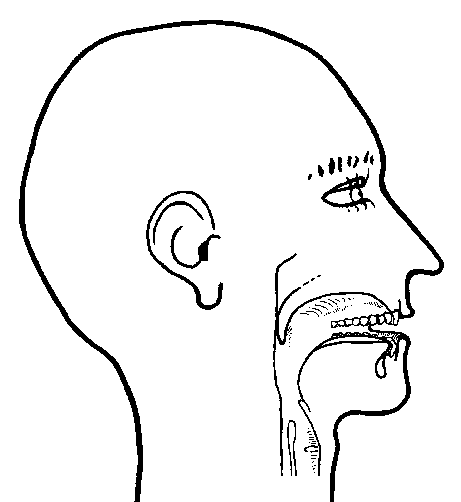 |
To decipher the significance of the letter shapes it is useful to consider a two-dimensional view of the head and neck. |
|
Various graphic devices are used in the letter diagrams. The two most important of these are the straight line, which refers to a line of tension, and the curved enclosure, which refers either to a region where sound resonates before emerging from the body as in ‘a’, ‘e’,‘o’ and ‘u’ or where pressure builds prior to a small explosion of air, as in ‘d’, ‘p’, ‘b’, and ‘q’. The region described by an enclosure is the air space in the mouth plus the parts of the tongue and mouth that are relaxed and free to vibrate. |
||
The cross at the top of the letter ‘t’ refers to the tongue's edge pressing against the upper gum ridge (top line of Xs in diagram). |
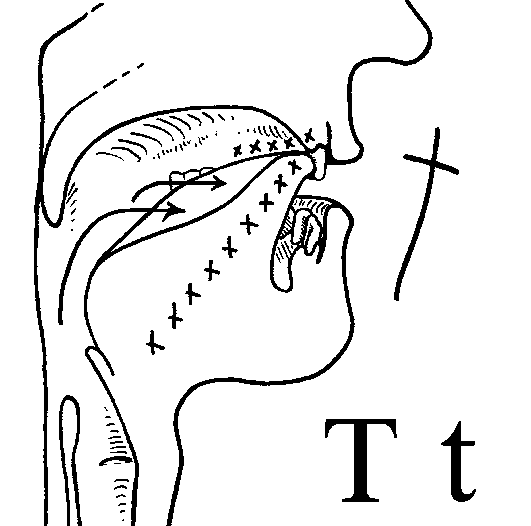 |
|
This blocks the air pushing up from the lungs. The tongue is tense (descending line of Xs in diagram and vertical stroke of the letter) and does not bulge forward as with the letter ‘d’ Note: the ‘t’ sound is produced without vibration of the vocal folds. |
||
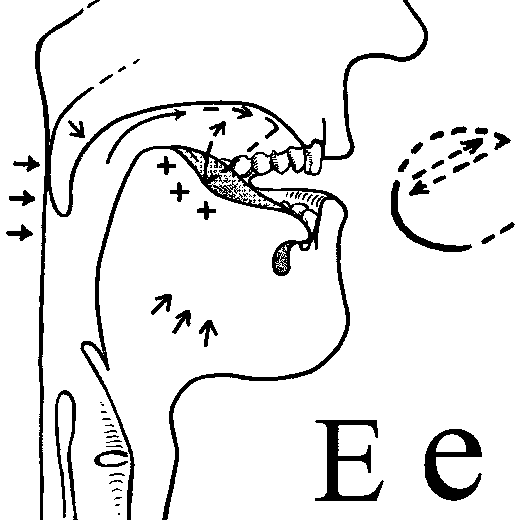
|
The sound of ‘e’ as in ‘egg’, is made as the mouth filters and resonates the buzz from the vocal folds. |
|
The wall of the pharynx and soft palate are tense and push forward (back arrows). The back of the tongue is raised and tense (lower Xs in diagram and curved lower stroke of the letter). The sound resonates high, and to the front of the mouth. The more acute ‘e’ as in ‘eke’ is pushed even higher and further forward. The tongue's movement is assisted by the lower cheeks pulling in (lower arrows). |
||
With the letter ‘a’ as in ‘apple’, there is tension at the front of the hard palate, down the front of the tongue and at the back of the tongue (Xs in diagram). |
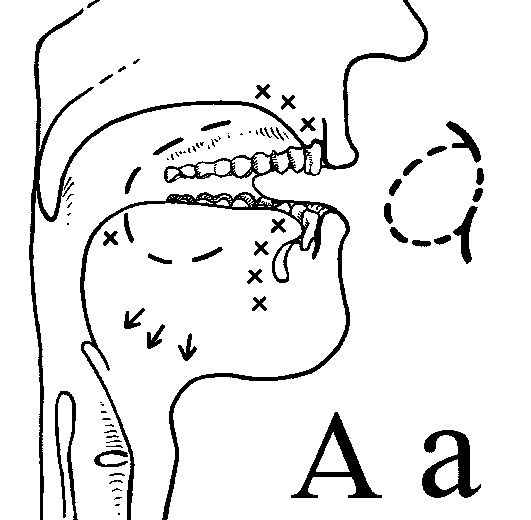 |
|
The middle of the tongue is lowered and relaxed with the lower cheeks pushing out. The resonance chamber is the air space in the mouth plus the relaxed part of the tongue (indicated by the curving line of dashes). Note: the tension at the back of the tongue moves forward for a more acute ‘a’ as in ‘ace’ and back and down for the ‘a’ in ‘pan’. |
||
Most letter shapes represent a sound at a middle level of acuteness. If you make a continuous sound from the ‘a’ in ‘ace’, through the ‘a’ in ‘apple’, to the ‘a’ in ‘pan’, you should notice a change in the resonating space from one that is high, narrow in width and near the front of the mouth to one that is low, wide and to the rear of the mouth. The letter ‘a’ is like one photo-frame taken from the middle of a movie recording the whole sequence. The sequence is caused by a collection of actions of the vocal mechanisms which I call the characteristic effect of the letter. |
||
The shapes that we use for our letters have been determined by thousands of individuals making thousands of subjective choices over thousands of years. So, no neat logical formula can be derived to explain them. Also, they occur in a spelling system where tradition and convention defy logical rules. However, if you look at the letters in the spelling of words as signifying their charactertistic effects, rather than their classic sounds, English spelling becomes almost understandable. |
||
Letters As Diagrams Of Sound. Like many things in life we accept the shapes of the letters of the alphabet as something that has been passed down by tradition without giving them much thought.
If you become aware of the sensation produced in the mouth and throat when you voice the basic sounds of the letters you may notice the letter shapes have a similarity to the shapes made by the sound.
Letters are shapes drawn on a two-dimensional grid provided by the surface of a page. They are representations of what is happening in the three-dimensional reality of our mouths, (and bodies), as we make each sound (in the fourth-dimension of time). |
 |
|
 |
To decipher the significance of the letter shapes it is useful to consider a two-dimensional view of the head and neck. |
|
Various graphic devices are used in the letter diagrams. The two most important of these are the straight line, which refers to a line of tension, and the curved enclosure, which refers either to a region where sound resonates before emerging from the body as in ‘a’, ‘e’,‘o’ and ‘u’ or where pressure builds prior to a small explosion of air, as in ‘d’, ‘p’, ‘b’, and ‘q’. The region described by an enclosure is the air space in the mouth plus the parts of the tongue and mouth that are relaxed and free to vibrate. |
||
The cross at the top of the letter ‘t’ refers to the tongue's edge pressing against the upper gum ridge (top line of Xs in diagram). This blocks the air pushing up from the lungs. The tongue is tense (descending line of Xs in diagram and vertical stroke of the letter) and does not bulge forward as with the letter ‘d’ Note: the ‘t’ sound is produced without vibration of the vocal folds. |
 |
|

|
The sound of ‘e’ as in ‘egg’, is made as the mouth filters and resonates the buzz from the vocal folds. The wall of the pharynx and soft palate are tense and push forward (back arrows). The back of the tongue is raised and tense (lower Xs in diagram and curved lower stroke of the letter). The sound resonates high, and to the front of the mouth. The more acute ‘e’ as in ‘eke’ is pushed even higher and further forward. The tongue's movement is assisted by the lower cheeks pulling in (lower arrows). |
|
With the letter ‘a’ as in ‘apple’, there is tension at the front of the hard palate, down the front of the tongue and at the back of the tongue (Xs in diagram). The middle of the tongue is lowered and relaxed with the lower cheeks pushing out. The resonance chamber is the air space in the mouth plus the relaxed part of the tongue (indicated by the curving line of dashes). Note: the tension at the back of the tongue moves forward for a more acute ‘a’ as in ‘ace’ and back and down for the ‘a’ in ‘pan’. |
 |
|
Most letter shapes represent a sound at a middle level of acuteness. If you make a continuous sound from the ‘a’ in ‘ace’, through the ‘a’ in ‘apple’, to the ‘a’ in ‘pan’, you should notice a change in the resonating space from one that is high, narrow in width and near the front of the mouth to one that is low, wide and to the rear of the mouth. The letter ‘a’ is like one photo-frame taken from the middle of a movie recording the whole sequence. The sequence is caused by a collection of actions of the vocal mechanisms which I call the characteristic effect of the letter. |
||
The shapes that we use for our letters have been determined by thousands of individuals making thousands of subjective choices over thousands of years. So, no neat logical formula can be derived to explain them. Also, they occur in a spelling system where tradition and convention defy logical rules. However, if you look at the letters in the spelling of words as signifying their charactertistic effects, rather than their classic sounds, English spelling becomes almost understandable. |
||
Hearing with your body.
Acoustic hearing.
Using breath to make sound.
From sound to speech.
Active reading.
From sound to symbol. (this page)